The Future of Famine
A look at reality.
If you want to know how bad things can get, just read a book by Yang Jisheng called Tombstone: The Great Chinese Famine 1958-1962. Droughts coincided with disastrous agricultural planning, resulting in crop failures and social collapse. Roughly 30-40 million people starved to death. Entire towns resorted to cannibalism. Parents ate their children, and children ate their siblings. If you dared to state the obvious, "there's no food," a party leader had you dragged into the mountains. At the same time, people dropped dead from hunger outside fully stocked grain depots, waiting for rations. They were too scared to steal anything. Other people fed human flesh to their families, insisting everything was fine. Many people who survived went insane. Yang watched his own father die from starvation. Officials knew exactly what was happening and why.
They just didn't care.
As Amartya Sen argued decades ago, famines don't happen out of nowhere. They're socially engineered. That's going to be the case even as climate change disrupts the world food supply.
Unfortunately, nobody can predict exactly when we'll wind up living like Cormac McCarthy characters, fighting over the last can of beans. We just know that we inch closer to that reality every day. We also know that all the food doesn't have to entirely disappear to cause big problems. In China, it took a 30 percent drop in crop production to kill 30 million. In many villages, there was enough food to feed everyone.
It was simply withheld.
A lot of us are exhausted by the swinging pendulum of headlines. One minute, everything's fine and we should stop panicking. The next minute, everything's a dumpster fire. News media ran alarming stories over the summer about corn harvests, but late rains saved us and some states saw their best harvests in years. That's how fast things can change. So I decided to get a more accurate look at our food security.
Here's what I found:
You can absolutely count on continued volatility in food prices and availability. That's going to become a new normal. If you want a reliable snapshot of our situation at any given time, you can use the food security portal maintained by the International Food Policy Research Institute. It tracks staples like rice, wheat, corn, soybeans, and coffee.
Here's their dashboard:
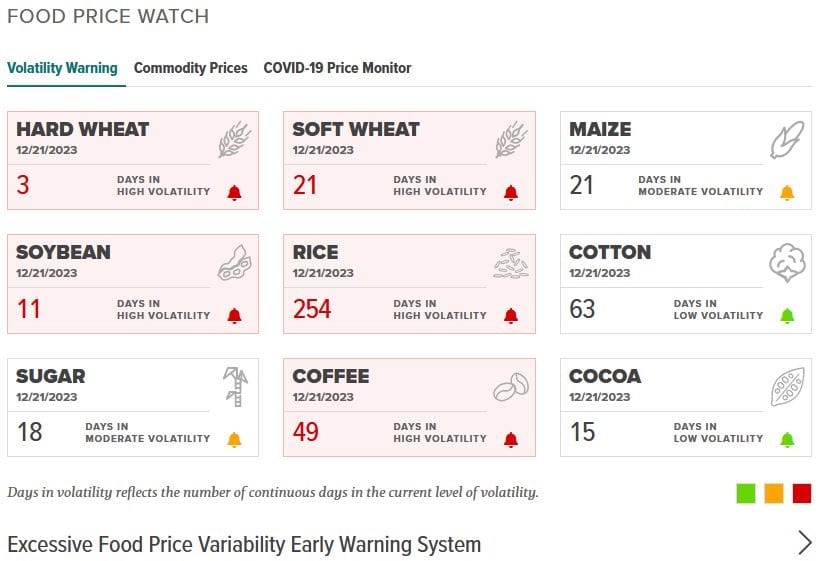
Climate science paints a clear picture of the future:
According to a 2023 study in njp Climate and Atmospheric Science, crop-killing heatwaves that used to happen once a century will now happen every six years in the U.S., and once every 16 years in China. As the authors explain, "extreme temperatures that used to have a 1 percent chance to occur in 1981 now have a 17 percent chance to occur in any given year."
In China, it's 6 percent.
Another 2023 study in Nature Communications says most current climate models significantly underestimate the risk of crop failures. For example, Brazil was expecting a record soybean harvest. Now they're facing the biggest crop loss in their history, plus threats to corn. According to a 2022 study in Science Advances, climate change has already tripled the risk of a trillion-dollar megalood in California's Central Valley. We're already seeing megafloods in places like Pakistan and Libya.
As of late 2023, 19 countries have imposed 41 different trade restrictions on everything from rice to onions. Extreme heat, droughts, storms, and floods are battering global food production. It doesn't help when wars drive up the price of fertilizer and other staples.
It's always worth paying attention to crop condition reports and news stories on floods and droughts, but you can also get a bird's eye view by looking at total global food production offered by the USDA's Foreign Agricultural Service. Slight caveat, there's a delay in reporting. Still, 2022 was supposed to be an awful year on several levels, but things held steady.
Here's global wheat production:
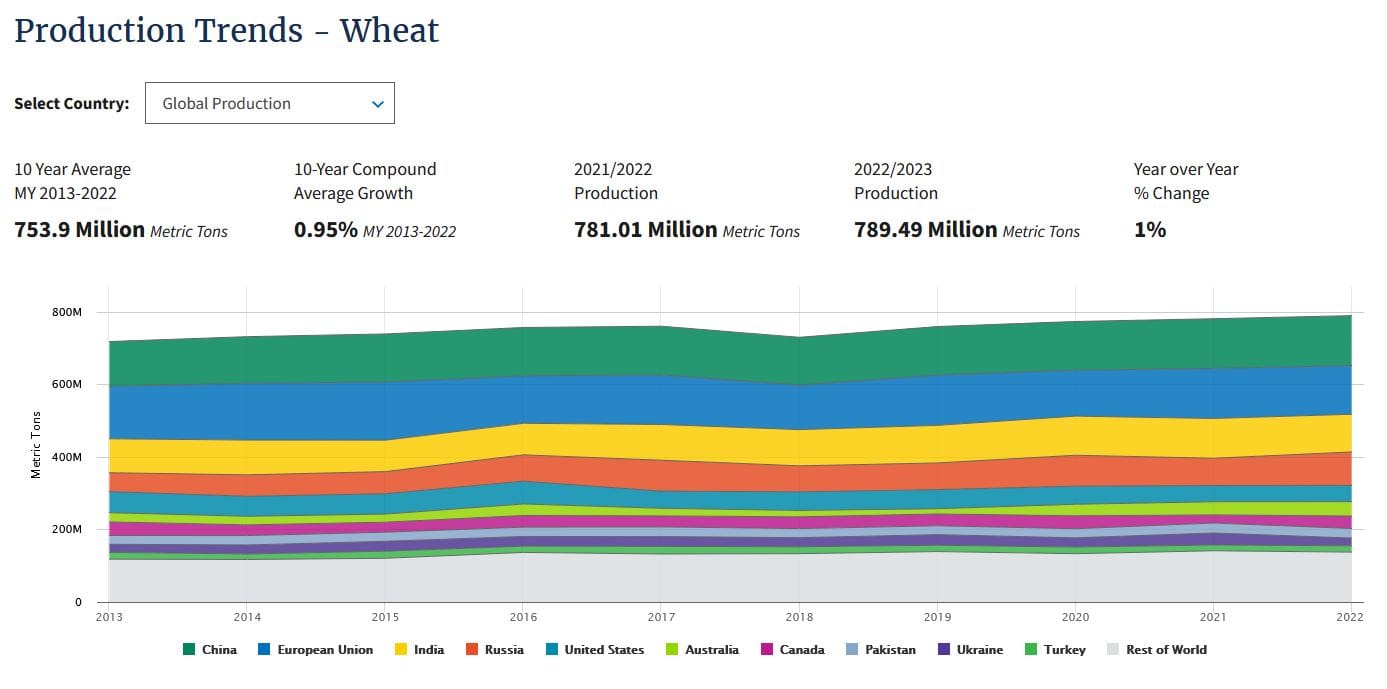
Not so much with corn:

It's hard to know exactly how things are going on any given day. That's why you also want to look at trends in the USDA charts, or the equivalent for wherever you live.
For example, here's corn production:
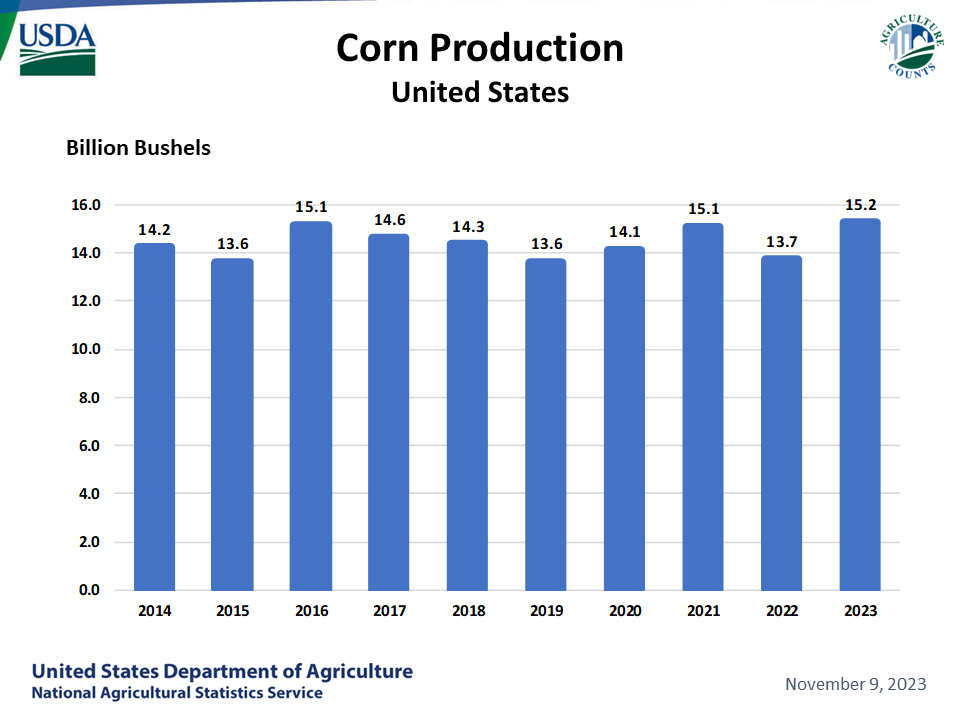
Here's winter wheat production:
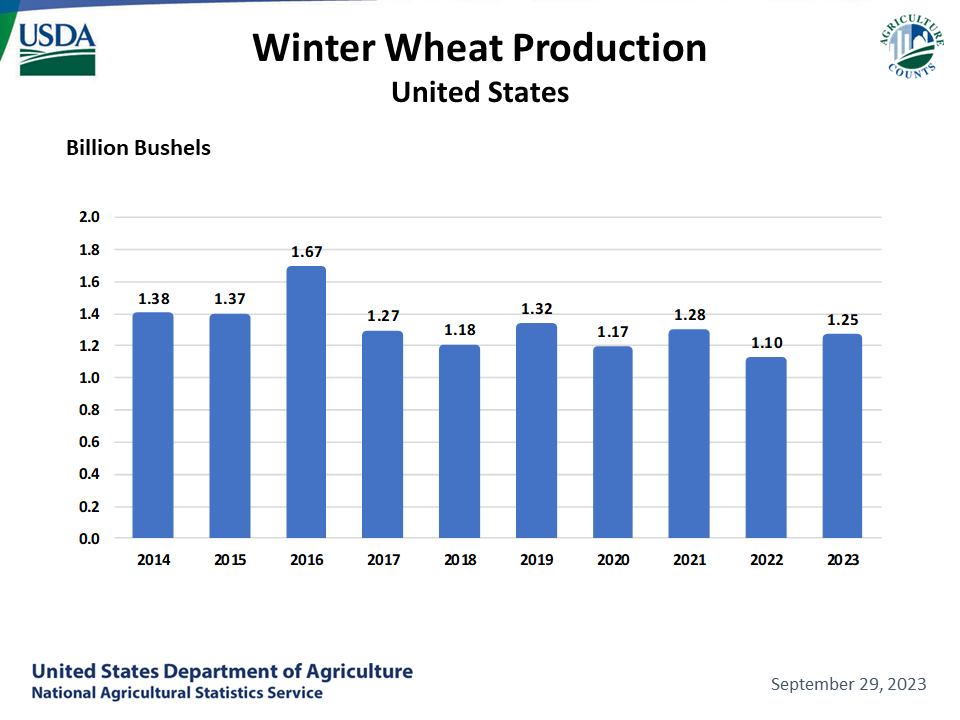
Here's soybean production:
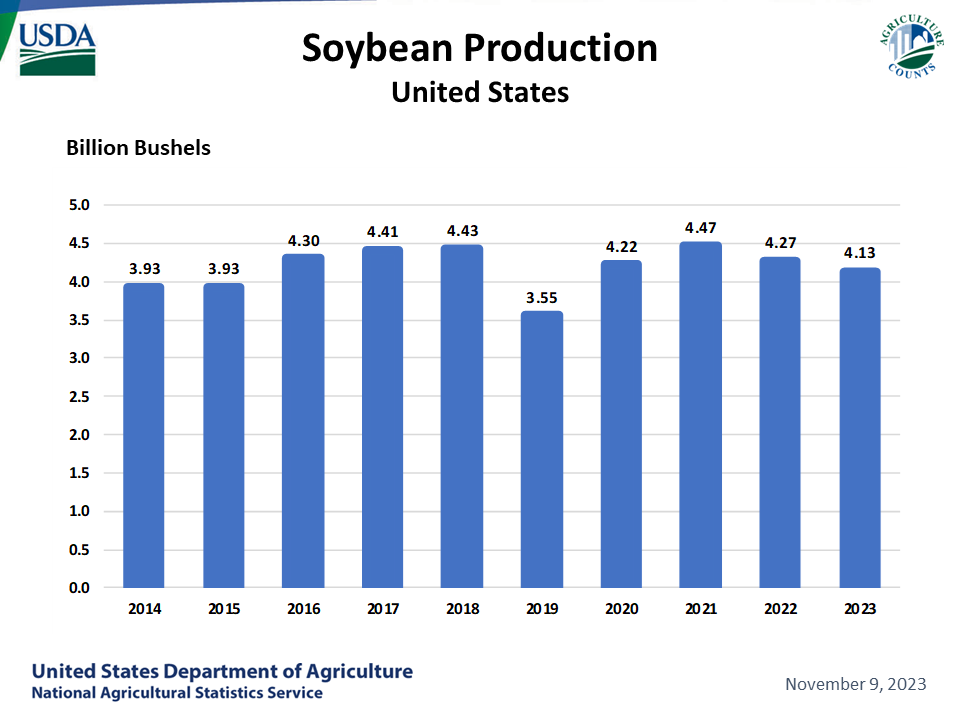
Here's the beef inventory:
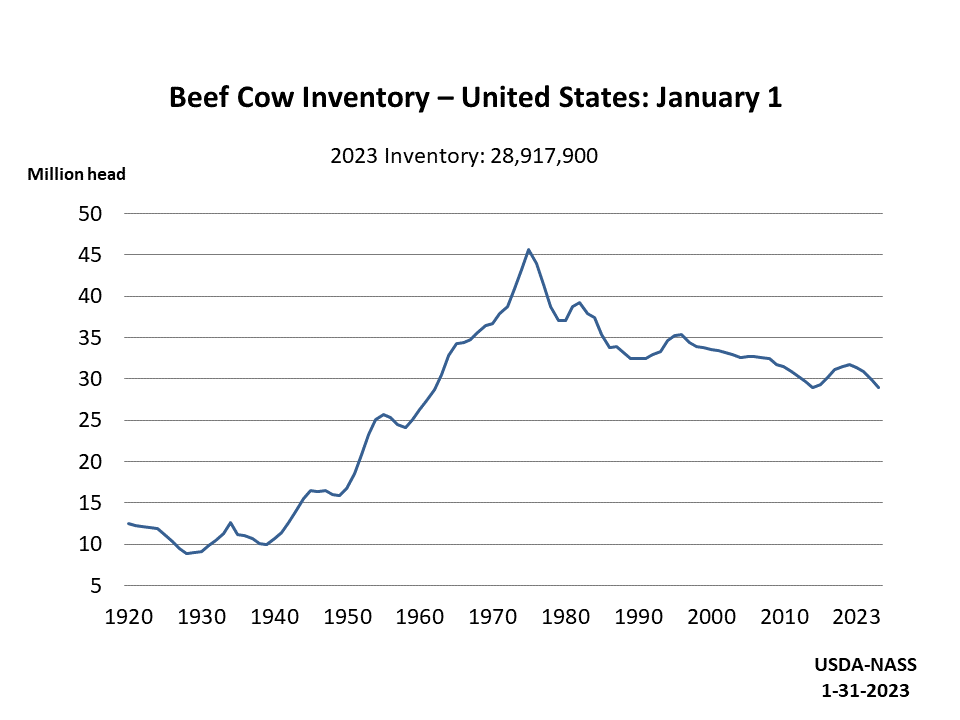
The charts provide a little context.
We can stare at graphs all day, but the history of famines warns us that it only takes one crop year to turn your neighbor into a cannibal. That said, we're not going to wake up to empty shelves tomorrow. If you live in Europe or North America, you're facing a slower disaster:
Food inflation.
Crop production is wobbling as the world bakes. That creates uncertainty on the market, and it drives up prices. And if someone can come up with an excuse to charge more, they're going to do it.
In fact, economists are finally admitting that corporate greed alone accounts for 60 percent of our recent inflation woes. New reports show profits in the double digits. They're raking in billions in extra money and spending it on stock buybacks and dividends. It's not costs from climate change yet, or even higher wages. It's just plain greed.
About 36 percent of American families and 38 percent of adults age 18-34 have already started skipping meals because they can't afford groceries. The same thing is happening in Europe. We can expect more of that as we countdown to 2030 and crop yields flicker while corporations see it as an opportunity to raise prices even higher. They've already proven that they have no interest in helping ordinary people. There's going to be more skipped meals, more shortages, stress and anger, and false promises.
We're only beginning to feel the bite of climate change. The 2023 UN Emissions Gap Report says that we're heading for 3C of warming. El Nino has been giving us a taste of that. Right now, it's mixed. When China has a bad wheat year, Russia has a good one. Brazil has a bad soybean year, but Argentina does okay. Big countries can buy food on the global market. But as protectionism emerges and superpowers try to weaponize food, it gets more and more unlikely that one country will bail out another one.
Here's where it gets scary:
Nobody really knows when the famines and breadbasket failures are going to start in earnest. With a strong El Nino supercharging extreme weather, the summer of 2024 looks like a good bet. But who knows?
It's hard to predict.
If nothing else, it's getting closer, and the timetable is moving up on us. Climate scientists generally agree that 2030 looks like the new 2050 now. We're knocking on disaster's door. With 2C and 3C of warming largely locked in at this point, we can't count on much of anything anymore. We're now living in the age of dragon king events, disasters amplified in likelihood and magnitude when systems begin catastrophic transitions.
We're definitely in one of those.
There's plenty of ways to prepare for shortages, like buying dry goods in bulk and storing them in mylar bags. It's a relatively privileged thing to do, and not exactly feasible if you're already skimping on meals and falling behind on rent. Plus, I honestly don't know how you:
A) Fend off thousands of hungry people.
B) Convince enough people to prepare for a famine.
C) Care for that many.
D) Get far enough away from them.
There's no reason why we can't adapt to the climate present by collectively shifting our diet away from meat, which not only consumes huge amounts of water but also huge amounts of grains. We could do lots of things to reduce the likelihood and the severity of a major crop failure.
We simply lack the will.
If you're a student of history, you know we've been here before. During the first few years of The Great Depression, there was a surplus of food but nobody could afford it. Prices tanked, and it drove farmers and grocers out of business. The surplus turned into shortage. The Dust Bowl made things worse. Instead of helping, politicians shrugged off widespread hunger and poverty. They preached self-reliance while sending police and military to beat protestors. It was only later, under FDR, that things started to calm down. When he took office, people begged him to declare martial law.
He didn't.
China kept its starving masses subdued through beatings, torture, and executions. They had their populations ripping tombstones out of the ground to use for irrigation projects and bases for backyard furnaces. That's where the book's title comes from. The millions who died during the famine were never buried or even mourned. They didn't get funerals. Some of them were cooked, others dumped into dry wells, others left for wild dogs who managed to avoid being eaten themselves.
Yang was never able to erect a tombstone for his father. Instead, he wrote an epic book as a monument to his memory.
The U.S. started to go down that route during the Depression, and it's starting to happen again. You can see the plans forming in police buildups like cop city, AI crime prevention algorithms, facial recognition, and drones. Fear and intimidation work wonders. If we're going to get through the next decade, we need another FDR. Unfortunately, I don't see one coming. We're going to have to settle for the next best thing.
You can stockpile all the food you want. You can learn to grow it. You can build community. You can train a militia. At some point, you need an honest assessment of your odds. When you're up against famine, there's hard limits. I'd rather know what they are.
Wouldn't you?
I don't want to spend the next five years chasing headlines and wondering what's going to happen. It's oddly soothing to know that there's plenty of information about the future lying in the past.
If nothing else, at least you'll know what's happening. Your mind will have a story arc for it.
We don't know exactly when the famines will start. That's kind of the point. If you have a computer and check up on the sources I've shared, you'll probably see it coming a few months away. You'll know that the world will have had plenty of warning.
They just didn't listen.
OK Doomer is supported by readers. If you appreciate this work, please subscribe or buy me a coffee.



